In today’s digital age, data synchronization has become crucial. From managing large databases to ensuring seamless information flow across platforms, synchronization is integral. One standard that stands out in this arena is the Study Data Tabulation Model (SDTM). While the idea might sound complex, this guide aims to break down SDTM in a manner that’s easy to grasp and relevant for data synchronization enthusiasts.
To ensure a comprehensive understanding, the SDTM explanation by Formedix provides invaluable insights, which will be referenced in this guide.

Understanding The Basics Of SDTM
Transitioning from the traditional data handling methods, you’ll find SDTM as a standard specifically designed for data exchange, primarily within the clinical research domain. It stands for Study Data Tabulation Model. It’s a global standard used to organize and format clinical trial data.
Why SDTM Matters In Data Synchronization
Have you ever considered why specific standards like SDTM have become so crucial? It’s not just about putting data into neat tables. In clinical research, you’re dealing with life-changing, sensitive information. Ensuring this data is synchronized across various platforms allows for accuracy and efficiency in trials and studies.
Benefits Of Using SDTM In Clinical Trials
It’s essential to grasp the tangible benefits. Here’s what you can look forward to:
Enhanced Consistency
SDTM provides a standardized approach to data representation, ensuring that every piece of data follows a predetermined format. This consistency enhances the overall quality and reliability of the data. Researchers, regulators, and sponsors can easily understand and compare data across studies, leading to more robust analyses and conclusions.
Improved Data Quality
SDTM requires a certain level of precision in data collection, transformation, and representation. This demand for accuracy and adherence to predefined standards inadvertently leads to better data quality. By using SDTM, you can minimize errors, inconsistencies, and data discrepancies, improving data integrity and reliability.
Streamlined Data Exchange
SDTM facilitates smoother and quicker data exchanges between different systems and organizations. Adhering to a common data structure and terminology allows data to be easily shared and integrated across various platforms and databases. This seamless data exchange promotes collaboration, allows for efficient data synchronization between multiple clinical trials, and supports the analysis of pooled data.
Challenges In Implementing SDTM
Transitioning into any new system or model isn’t without challenges. When you’re considering SDTM:
Initial Setup
Adopting SDTM requires transitioning from existing data models and workflows to aligning with SDTM standards. This initial setup can be time-consuming and may require significant investment in time, resources, and expertise. It involves mapping existing data to SDTM domains and variables, transforming data into the required format, and ensuring consistency in data representation. The complexity of the initial setup can vary depending on the size and complexity of the study data, as well as the existing infrastructure and systems in place.
Training
Not everyone involved in clinical trials may know SDTM and its implementation requirements. Training becomes crucial to ensure that teams understand and utilize SDTM effectively. This includes training on SDTM principles, data mapping techniques, standards, and conventions, and using SDTM-compliant tools and software. Providing comprehensive training sessions can be time-consuming and may require dedicated resources. However, investing in training is essential to ensure that teams have the necessary skills and knowledge to implement SDTM properly.

How To Navigate The Implementation Process
While challenges exist, they aren’t insurmountable. Here are steps to ensure a smoother transition:
1. Conduct Training Sessions
Before diving into SDTM implementation, it is crucial to ensure that your team has a thorough understanding of SDTM principles and guidelines. Consider organizing training sessions or workshops to educate your team on the intricacies of SDTM. By ensuring that everyone involved is on the same page, you can minimize confusion and promote effective collaboration throughout the implementation process.
2. Use The Right Tools
Implementing SDTM manually can be time-consuming and prone to errors. Fortunately, there are several software solutions available that are specifically designed to facilitate SDTM implementation. These tools offer features such as data mapping, validation checks, and data transformation capabilities, which can significantly reduce manual errors and speed up implementation. By leveraging these tools, you can streamline the implementation process and ensure the data is mapped accurately and consistently.
3. Stay Updated
SDTM, like any standard, evolves. It is vital to stay current with the latest updates and guidance CDISC provides. This ensures you are always in sync with the current requirements and best practices. Subscribe to CDISC newsletters, attend webinars or conferences, and actively participate in forums or communities related to SDTM. Stay informed about the latest developments to ensure your SDTM implementation aligns with industry standards and regulatory expectations.
The Future Of SDTM In Data Synchronization
As the need for synchronized, high-quality data grows, SDTM’s importance will only rise. Its structure and methodology make it adaptable for future needs, ensuring it remains relevant in the evolving landscape of clinical trials and data synchronization.
With technological advancements, we may see more integrations and tools, making the SDTM adoption process even more streamlined. As data grows, so will the need for efficient, reliable standards like SDTM.
Conclusion
Diving into the world of SDTM might seem daunting at first. Still, its significance in ensuring quality, synchronized data is undeniable. While challenges exist in its adoption, you can effectively integrate it with the right tools and mindset into your data processes. As a data synchronization enthusiast, understanding and leveraging SDTM is beneficial and essential for the future.